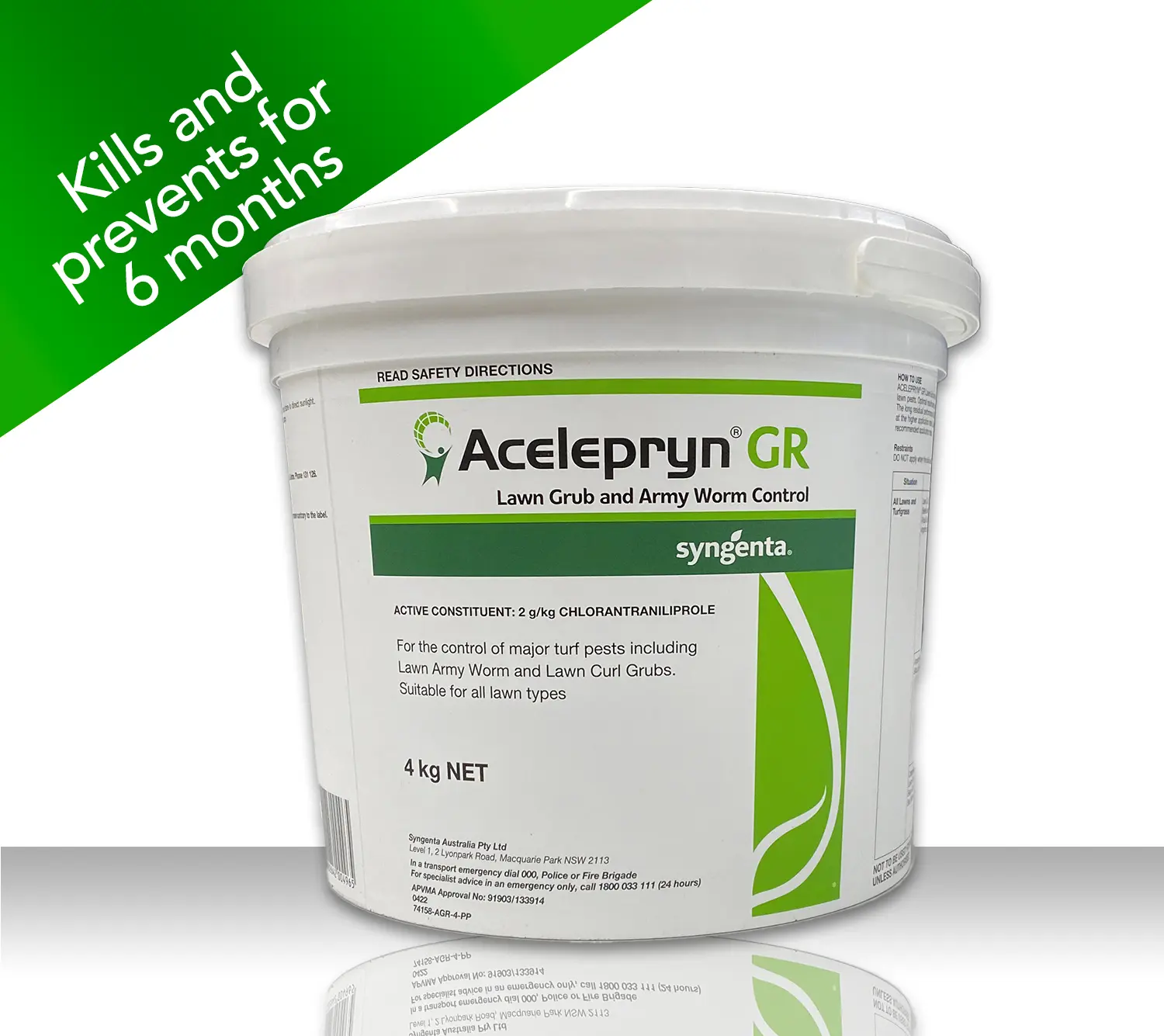Armyworms are aptly called because they travel in large groups, moving across your lawn in a linear fashion, much like an army would in an attack. Armyworms are native to the American tropics, but their ability to migrate and travel long distances has made them a cause of concern in certain areas. Because of their ability to travel and reproduce rapidly, Armyworms are now widespread across the top half of Australia with populations migrating south in warmer summers.
The term armyworm is a misnomer, as armyworms are not worms; they are caterpillars and are the larval forms of the armyworm moth. Armyworms can devour large patches of foliage in a short amount of time, all thanks to their sheer number. If left untreated, an armyworm infestation can remove the leaves of your entire lawn in 1-3 nights..
Your lawn is a luscious spread through the eyes of an armyworm colony, and they’ve got the numbers to cover it. We’ll help walk you through how to spot an armyworm infestation in its early stages and how to get rid of armyworms in your lawn- for good.
What Are Armyworms?
Armyworms thrive in the warmer months, and hot summer nights are when armyworms peak in activity. Armyworms can also survive mild winters but cannot thrive in harsh winter conditions. This means they generally overwinter in the tropics in northern Australia. As a result, damage generally starts first in Queensland in December and the pest spreads south as Summer goes on. Armyworm larvae are caterpillars. These caterpillars are the larvae of the moth Spodoptera mauritia which can produce around 200 to 300 eggs in a single laying. In a month, a single month can lay up to 1000 eggs. Because they multiply so rapidly, knowing how to get rid of armyworms is crucial to saving your lawn.
Armyworms vary in size and colour. Armyworms can be green, black, or brown. A typical armyworm larva goes through various stages in the course of 5 to 10 days. After this larval stage, it reaches maturity and pupates to emerge as an adult. Adult armyworms turn into moths and repeat the cycle with the next armyworm generation.
There can be up to three generations of armyworms feeding on your lawn from summer to autumn. There are different species of armyworms, but typically, they share the following characteristics:
- An inverted “Y” mark in the head capsule
- Can reach a maximum length of 4cm
- Green, yellow, brown, or red stripes along the length of their bodies
- A small white dot at the centre of each forewing
- Adult moths have dark margins on the hind wings
Armyworms are more active during the night. The caterpillars bury into the ground during the daytime and are out of sight. Because of their nocturnal nature, armyworms may be challenging to catch in action during the day. Armyworms in lawn areas can be easily seen during the night, especially when the moths are out.
If you see these moths hovering over your lawn at night, it may be a sign that you have an armyworm infestation right under your nose. One of the first steps for getting rid of armyworms is knowing how to identify signs of an infestation.
- Presence of caterpillar droppings which are yellow-green.
- Presence of silken cocoons.
- A group of moths hovering over the lawn at night.
- Fast spreading damage to the lawn
- Stalk like appearance where the leaves of the lawn have been eaten
- Caterpillars burrowed under the ground during the daytime.
What Damage do Armyworms Cause?
Armyworms are considered one of the major agricultural pests worldwide. Armyworms can cause extensive damage to healthy lawns, but spotting the first signs of armyworm infestation can help save yours. Watch out for patches of brown grass- these are the first signs of armyworms in lawn areas. These patches will eventually spread as the armyworm colonies eat through your lawn. As they are caterpillars they love eating the leaves, so get down close and check out what part of the lawn is being eaten.
Armyworms not only cause damage to lawns but also cause damage to large crop plantations. According to the Grains Research and Development Corporation, there were more armyworm infestation reports in 2020 than ever in the past 14 years.
You can quickly identify armyworm damage when you look closely at the damage and see the following:
- Ragged blades of grass, where all the fleshy leaf has
- Flat and discoloured patches of grass
- Linear lines of destruction as the army marches forward
- Fast damage, if it occurred overnight then thats a good indicator
Although armyworms will not completely kill your lawn the loss of leaf can leave it looking dead.
How to Check For Armyworms
Armyworms are typically found in the Northern Territory, Queensland, New South Wales and the Australian Capital Territory. However, because armyworms are highly mobile, they can cause an infestation in other Australian regions.
Correctly identifying armyworms is crucial to saving your lawn. A full-blown armyworm infestation can damage your yard in one night. By the time you notice, armyworms would have already done extensive damage. Since armyworms do the most damage during nighttime, it can be hard to catch them in action. Armyworms in lawn areas work fast, and knowing how to quickly identify can make all the difference between devastation and saving your lawn.
Identify armyworms in your lawn by following these tips:
Keep an outdoors light on during the night
Armyworms do most of the damage during nighttime. If you have a hunch that there is an impending armyworm infestation in your yard, keep the area illuminated at night with an outdoor lamp. It would be best to do this during warm nights when armyworm caterpillars and armyworm moths are actively feeding.
Watch out for swarms of moths hovering around the light. This sign indicates an armyworm colony growing in your yard. If you see this, you will need to take steps and learn how to get rid of armyworms.
- Shine a bright light on areas where you suspect damage; the presence of webbing and caterpillars are a clear indicator of armyworms in your lawn.
- Bright lights will attract moths- watch out for moths gathering in outside light sources at night.
The Soapy Water Method
Another way to check for the presence of armyworms is the tried and tested soapy water method. To do this, you need to pour a bucket of soapy water in areas of your lawn where you suspect an armyworm infestation is starting. Fill a bucket with 9 litres of water mixed with 50ml dishwashing detergent.
Pour this mixture over an area measuring about one square metre. Monitor this area for about ten to fifteen minutes and watch burrowed caterpillars come to the surface. If you highly suspect an infestation, but no caterpillars come out when applying this method, you can try the following night again.
How to Get Rid of Armyworms
Apply Insecticide
Treating the armyworm infestation on your lawn is crucial to saving it. Applying a fast acting insecticide is crucial to get rid of armyworms.
Chlorantraniliprole is a safe new chemical which is the professional standard for treatment and prevention of armyworm. Available as a granular product called Acelepryn the product is fast becoming a popular choice for homeowners.
With a great safety profile there is no need to wear PPE when applying. The resealable bag allows for years of protection on smaller lawns. Acelepryn also has low environmental toxicity, so there’s no concern about damage to many off-target organisms like bees and earthworms.
With strong binding in the soil and low water solubility Acelepryn hangs around in the ground, protecting against any new waves of eggs that hatch after application.
How to Prevent Armyworms From Coming Back
Knocking out the larvae is only half the battle, as mentioned before they are prolific egg layers. So, applying a long-lasting insecticide like Acelepryn insecticide (that has residual control) is the best way to get rid and prevent armyworms, protecting your lawn. However, constant monitoring and keeping a vigilant eye for infestations is critical, especially in the warmer months, to ensure your lawn remains healthy.
Applying Acelepryn as a preventative measure is highly recommended. Summary
Treating an armyworm infestation on your lawn should be an easy task, With the proper knowledge and tools, you can say goodbye to those crawling pests faster than they can go through your lawn. Knowing how to get rid of armyworms is essential, especially during the warmer months, when they are actively migrating.
The best way to remove armyworms is to treat with Acelepryn at the first sign of damage or preferably apply preventatively in September.
Do you want to know more about how to get the best results in keeping those armyworms away? Visit our page here.
Frequently Asked Questions
Can armyworms kill grass?
No. Generally speaking, armyworms feeding on your grass will not kill it, but it will cause extensive damage, so much so it will look dead. However without treatmentit will lead to the grass on your lawn eventually dying.
When do armyworms come out?
Armyworms come out and do the most damage during the night. In the daytime, the larvae burrow into the soil.
Is an armyworm a caterpillar?
Yes. Armyworms are caterpillars, and they are the larval stage of the armyworm moth.
Will armyworms die in winter?
Armyworms cannot survive harsh weather conditions and die during the cold winter months. However, armyworms can survive mild winters and may continue to do damage during these seasons.




